Global Cleaning Robot Market, By Product Type, By Operation Mode, By Application, By Sales Channel, By Region & Segmental Insights Trends and Forecast, 2024 – 2034
- Industry: Technology
- Report ID: TNR-110-1201
- Number of Pages: 420
- Table/Charts : Yes
- July, 2024
- Base Year : 2024
- No. of Companies : 10+
- No. of Countries : 29
- Views : 10154
- Covid Impact Covered: Yes
- War Impact Covered: Yes
- Formats : PDF, Excel, PPT
A cleaning robot is an autonomous or semi-autonomous device designed to perform various cleaning tasks without human intervention. These robots are equipped with sensors, artificial intelligence (AI), and navigation systems to efficiently clean spaces such as homes, offices, and industrial environments. Cleaning robots come in different forms, including vacuum cleaners, floor scrubbers, and window cleaners. The cleaning robot market is experiencing significant growth, driven by advancements in AI and IoT technologies.
These robots, designed for various cleaning tasks, are increasingly adopted in residential, commercial, and industrial settings due to their efficiency and convenience. Key trends include the integration of smart features, such as voice control and app connectivity, which enhance user experience and operational efficiency. Additionally, the rise in awareness regarding hygiene and cleanliness, especially post-pandemic, has amplified the demand for automated cleaning solutions.
Opportunities in the market are abundant, with the expansion into emerging markets and the development of more affordable, versatile models. Innovations like robots capable of multi-surface cleaning and those equipped with advanced navigation systems present significant growth potential. The primary growth driver for the Cleaning Robot market is the increasing consumer preference for smart home devices, coupled with the rising labor costs and the need for efficient cleaning solutions in commercial spaces. In Terms of Revenue, the Global Cleaning Robot Market was Worth US$ 6.5 Bn in 2023, Anticipated to Witness CAGR of 22.7% During 2024 – 2034.

Trends in the Global Cleaning Robot Market
- Integration of Smart Technologies: Modern cleaning robots are increasingly equipped with AI and IoT capabilities, allowing for advanced features such as voice control, remote operation via smartphone apps, and real-time monitoring. These smart features enable users to schedule cleanings, receive maintenance alerts, and control the robot from anywhere, significantly enhancing convenience and user experience. Furthermore, advancements in AI allow these robots to learn and adapt to different environments, improving their efficiency and effectiveness. For instance, in January 2024, Samsung Electronics announced the launch of an advanced line of AI-powered vacuum cleaners at CES® 2024. Aimed at simplifying household chores, the Bespoke Jet Bot Combo™ vacuum and mop robot cleaner will feature enhanced AI capabilities and steam cleaning functions. This trend not only caters to tech-savvy consumers but also drives the adoption of cleaning robots in commercial spaces where intelligent, automated cleaning solutions are highly valued.
- Expansion into Specialized Cleaning Solutions: Manufacturers are developing robots tailored to specific cleaning tasks, such as window cleaning, pool maintenance, and gutter cleaning. This diversification caters to a broader range of consumer needs and opens up new market segments. For example, robots designed for industrial applications can handle heavy-duty cleaning in factories and warehouses, reducing the reliance on manual labor and improving operational efficiency. Similarly, robots for healthcare facilities are equipped with advanced sterilization features to maintain high hygiene standards. For instance, in June 2020, LG Electronics entered into an agreement with Miele & Cie. KG, granting Miele the rights to utilize LG’s patented robot vacuum cleaner technology. This trend highlights the industry’s move towards providing comprehensive, targeted cleaning solutions, addressing both residential and commercial demands.
Floor cleaning robots by product type category has emerged as a dominant segment in the global cleaning robot market, driven by their widespread adoption in residential, commercial, and industrial settings. These robots, designed to vacuum, mop, and sweep floors, offer unmatched convenience and efficiency. Their popularity stems from advanced features such as AI-powered navigation, obstacle detection, and automatic recharging. Consumers appreciate the ability to schedule cleanings and control the robots remotely via smartphone apps. The increased emphasis on hygiene, especially post-pandemic, has further boosted demand. Innovations in multi-surface cleaning capabilities and improved suction power have made floor cleaning robots indispensable for maintaining cleanliness in various environments, solidifying their leading position in the market.
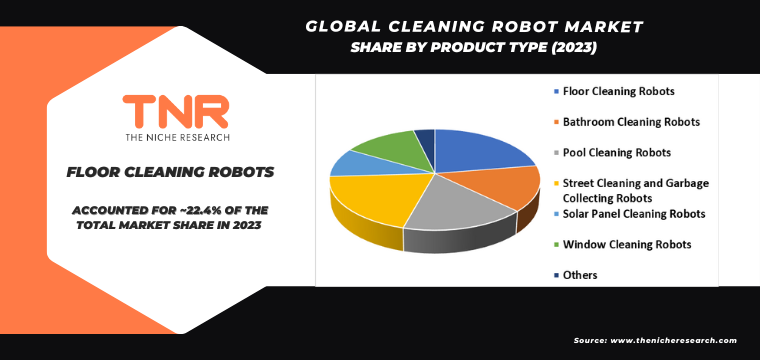
In 2023, the remote-control segment solidified its position as the second-largest category within the global cleaning robot market. This growth is attributed to the rising demand for user-friendly, convenient cleaning solutions. Remote-controlled cleaning robots offer enhanced flexibility, allowing users to operate and navigate the robots from a distance using dedicated remote controllers or smartphone apps. These devices often come with features such as customized cleaning schedules, spot cleaning, and real-time monitoring, making them highly appealing to busy consumers. The ability to control the cleaning process remotely, even from outside the home, adds a layer of convenience that resonates with modern lifestyles. This segment’s robust performance underscores the ongoing trend toward smarter, more adaptable home cleaning solutions.
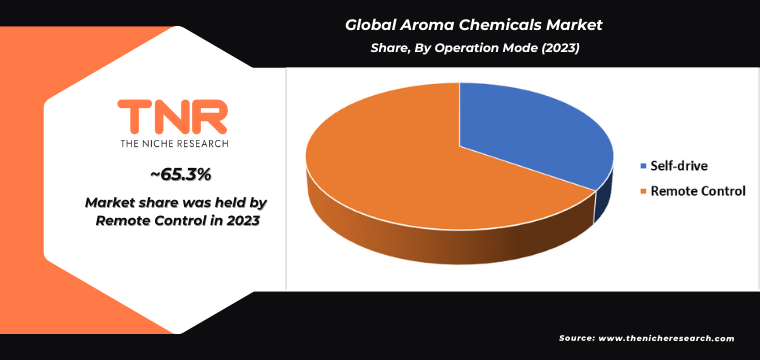
Residential segment, categorized by application, has exerted significant dominance over the global cleaning robot market. This is driven by the increasing demand for automated and efficient home cleaning solutions. Homeowners are turning to cleaning robots for their convenience, time-saving capabilities, and advanced features such as AI-powered navigation, automatic scheduling, and multi-surface cleaning. The rise in dual-income households, coupled with the growing awareness of hygiene and cleanliness, has further propelled this segment. Additionally, technological advancements and the integration of smart home systems have made these robots more accessible and user-friendly. As a result, the residential application of cleaning robots continues to lead the market, meeting the evolving needs of modern households.
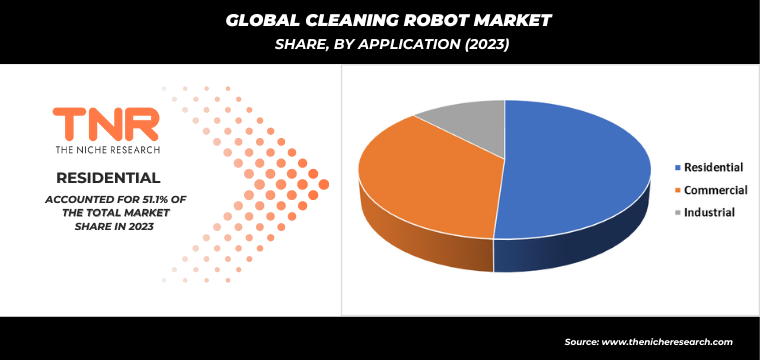
By sales channel, offline segment is anticipated to grow fastest over the forecast timeline in global cleaning robot market. This surge is attributed to the tangible benefits of in-store shopping, where consumers can directly interact with products and receive personalized assistance from knowledgeable sales staff. Many customers prefer to physically see and test cleaning robots before making a purchase, ensuring they select the best model for their needs. Retail stores often provide live demonstrations, detailed product explanations, and immediate post-purchase support, enhancing consumer confidence. Furthermore, strategic partnerships with major retail chains and the expansion of brick-and-mortar stores in emerging markets are driving this segment’s rapid growth and increasing market penetration.
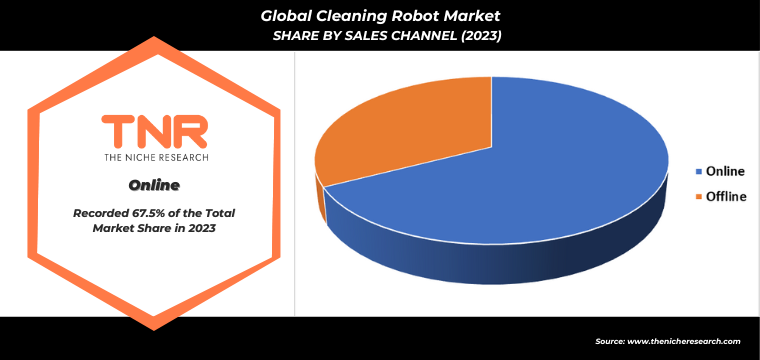
In 2023, North America solidified its dominance in the global cleaning robot market, contributing a revenue share of 36.2%. This leadership is driven by the region’s high adoption rate of advanced home automation technologies and a strong emphasis on maintaining cleanliness and hygiene. Consumers in North America show a marked preference for innovative, time-saving solutions, contributing to the widespread uptake of cleaning robots. The presence of key market players and continuous technological advancements further bolster market growth. Additionally, increasing disposable incomes and a growing trend of smart homes are significant factors propelling the demand for cleaning robots in this region. As a result, North America remains a pivotal market, setting trends and standards in the cleaning robot industry.
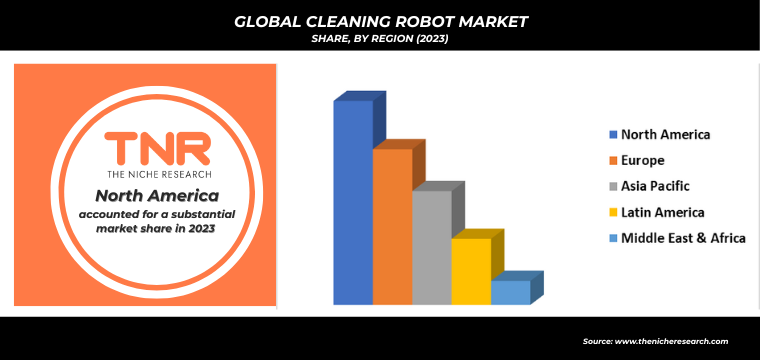
Competitive Landscape
Some of the players operating in the cleaning robot market are
- bObsweep
- Dyson Ltd.
- Ecovacs Robotics Inc.
- Electrolux
- ICRA
- ILIFE Robotics Technology
- iRobot Corporation
- Kärcher
- LG Electronics
- Maytronics
- Milagrow Business and Knowledge Solutions Pvt. Ltd.
- Neato Robotics Inc.
- Nilfisk Group
- Pentair Plc
- Samsung Electronics Co. Ltd.
- SharkNinja
- Other Industry Participants
Global Cleaning Robot Market Scope
| Report Specifications | Details |
| Market Revenue in 2023 | US$ 6.5 Bn |
| Market Size Forecast by 2034 | US$ 61.4 Bn |
| Growth Rate (CAGR) | 22.7% |
| Historic Data | 2016 – 2022 |
| Base Year for Estimation | 2023 |
| Forecast Period | 2024 – 2034 |
| Report Inclusions | Market Size & Estimates, Market Dynamics, Competitive Scenario, Trends, Growth Factors, Market Determinants, Key Investment Segmentation, Product/Service/Solutions Benchmarking |
| Segments Covered | By Product Type, By Operation Mode, By Application, By Sales Channel, By Region |
| Regions Covered | North America, Europe, Asia Pacific, Middle East & Africa, Latin America |
| Countries Covered | U.S., Canada, Mexico, Rest of North America, France, The UK, Spain, Germany, Italy, Nordic Countries (Denmark, Finland, Iceland, Sweden, Norway), Benelux Union (Belgium, The Netherlands, Luxembourg), Rest of Europe, China, Japan, India, New Zealand, Australia, South Korea, Southeast Asia (Indonesia, Thailand, Malaysia, Singapore, Rest of Southeast Asia), Rest of Asia Pacific, Saudi Arabia, UAE, Egypt, Kuwait, South Africa, Rest of Middle East & Africa, Brazil, Argentina, Rest of Latin America |
| Key Players | bObsweep, Dyson Ltd., Ecovacs Robotics Inc., Electrolux, ICRA, ILIFE Robotics Technology, iRobot Corporation, Kärcher, LG Electronics, Maytronics, Milagrow Business and Knowledge Solutions Pvt. Ltd., Neato Robotics Inc., Nilfisk Group, Pentair Plc, Samsung Electronics Co. Ltd., SharkNinja |
| Customization Scope | Customization allows for the inclusion/modification of content pertaining to geographical regions, countries, and specific market segments. |
| Pricing & Procurement Options | Explore purchase options tailored to your specific research requirements |
| Contact Details | Consult With Our Expert
Japan (Toll-Free): +81 663-386-8111 South Korea (Toll-Free): +82-808- 703-126 Saudi Arabia (Toll-Free): +966 800-850-1643 United Kingdom: +44 753-710-5080 United States: +1 302-232-5106 E-mail: askanexpert@thenicheresearch.com
|
Global Cleaning Robot Market
By Product Type
- Floor Cleaning Robots
- Bathroom Cleaning Robots
- Pool Cleaning Robots
- Street Cleaning and Garbage Collecting Robots
- Solar Panel Cleaning Robots
- Window Cleaning Robots
- Others
By Operation Mode
- Self-drive
- Remote Control
By Application
- Residential
- Commercial
- Industrial
By Sales Channel
- Online
- Offline
By Region
- North America (U.S., Canada, Mexico, Rest of North America)
- Europe (France, The UK, Spain, Germany, Italy, Nordic Countries (Denmark, Finland, Iceland, Sweden, Norway), Benelux Union (Belgium, The Netherlands, Luxembourg), Rest of Europe)
- Asia Pacific (China, Japan, India, New Zealand, Australia, South Korea, Southeast Asia (Indonesia, Thailand, Malaysia, Singapore, Rest of Southeast Asia), Rest of Asia Pacific)
- Middle East & Africa (Saudi Arabia, UAE, Egypt, Kuwait, South Africa, Rest of Middle East & Africa)
- Latin America (Brazil, Argentina, Rest of Latin America)
Report Layout:
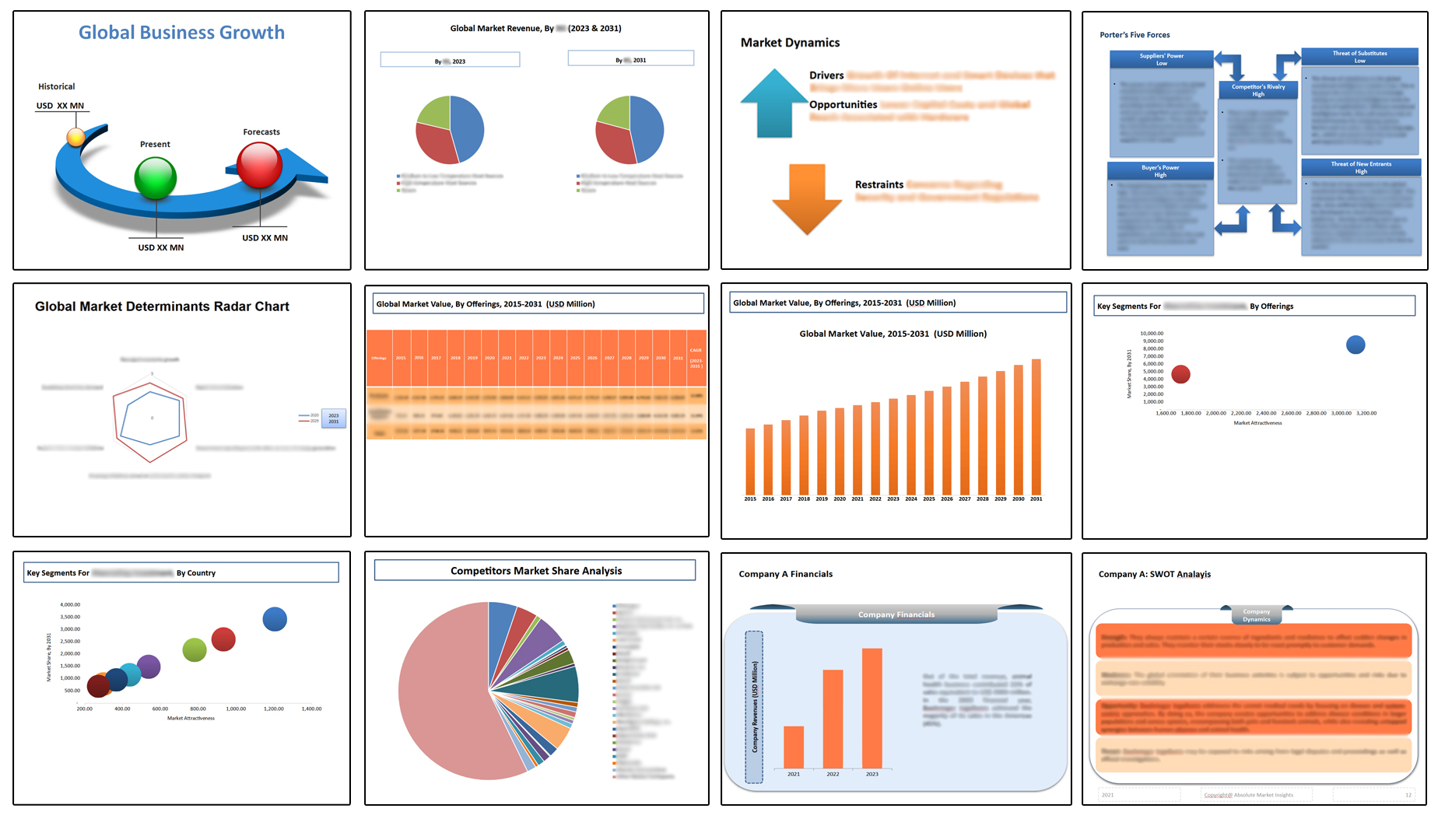
Table of Contents
Note: This ToC is tentative and can be changed according to the research study conducted during the course of report completion.
**Exclusive for Multi-User and Enterprise User.
Global Cleaning Robot Market
By Product Type
- Floor Cleaning Robots
- Bathroom Cleaning Robots
- Pool Cleaning Robots
- Street Cleaning and Garbage Collecting Robots
- Solar Panel Cleaning Robots
- Window Cleaning Robots
- Others
By Operation Mode
- Self-drive
- Remote Control
By Application
- Residential
- Commercial
- Industrial
By Sales Channel
- Online
- Offline
By Region
- North America (U.S., Canada, Mexico, Rest of North America)
- Europe (France, The UK, Spain, Germany, Italy, Nordic Countries (Denmark, Finland, Iceland, Sweden, Norway), Benelux Union (Belgium, The Netherlands, Luxembourg), Rest of Europe)
- Asia Pacific (China, Japan, India, New Zealand, Australia, South Korea, Southeast Asia (Indonesia, Thailand, Malaysia, Singapore, Rest of Southeast Asia), Rest of Asia Pacific)
- Middle East & Africa (Saudi Arabia, UAE, Egypt, Kuwait, South Africa, Rest of Middle East & Africa)
- Latin America (Brazil, Argentina, Rest of Latin America)
The Niche Research approach encompasses both primary and secondary research methods to provide comprehensive insights. While primary research is the cornerstone of our studies, we also incorporate secondary research sources such as company annual reports, premium industry databases, press releases, industry journals, and white papers.
Within our primary research, we actively engage with various industry stakeholders, conducting paid interviews and surveys. Our meticulous analysis extends to every market participant in major countries, allowing us to thoroughly examine their portfolios, calculate market shares, and segment revenues.
Our data collection primarily focuses on individual countries within our research scope, enabling us to estimate regional market sizes. Typically, we employ a bottom-up approach, meticulously tracking trends in different countries. We analyze growth drivers, constraints, technological innovations, and opportunities for each country, ultimately arriving at regional figures.Our process begins by examining the growth prospects of each country. Building upon these insights, we project growth and trends for the entire region. Finally, we utilize our proprietary model to refine estimations and forecasts.
Our data validation standards are integral to ensuring the reliability and accuracy of our research findings. Here’s a breakdown of our data validation processes and the stakeholders we engage with during our primary research:
- Supply Side Analysis: We initiate a supply side analysis by directly contacting market participants, through telephonic interviews and questionnaires containing both open-ended and close-ended questions. We gather information on their portfolios, segment revenues, developments, and growth strategies.
- Demand Side Analysis: To gain insights into adoption trends and consumer preferences, we reach out to target customers and users (non-vendors). This information forms a vital part of the qualitative analysis section of our reports, covering market dynamics, adoption trends, consumer behavior, spending patterns, and other related aspects.
- Consultant Insights: We tap into the expertise of our partner consultants from around the world to obtain their unique viewpoints and perspectives. Their insights contribute to a well-rounded understanding of the markets under investigation.
- In-House Validation: To ensure data accuracy and reliability, we conduct cross-validation of data points and information through our in-house team of consultants and utilize advanced data modeling tools for thorough verification.
The forecasts we provide are based on a comprehensive assessment of various factors, including:
- Market Trends and Past Performance (Last Five Years): We accurately analyze market trends and performance data from preceding five years to identify historical patterns and understand the market’s evolution.
- Historical Performance and Growth of Market Participants: We assess the historical performance and growth trajectories of key market participants. This analysis provides insights into the competitive landscape and individual company strategies.
- Market Determinants Impact Analysis (Next Eight Years): We conduct a rigorous analysis of the factors that are projected to influence the market over the next eight years. This includes assessing both internal and external determinants that can shape market dynamics.
- Drivers and Challenges for the Forecast Period:Identify the factors expected to drive market growth during the forecast period, as well as the challenges that the industry may face. This analysis aids in deriving an accurate growth rate projection.
- New Acquisitions, Collaborations, or Partnerships: We keep a close watch on any new acquisitions, collaborations, or partnerships within the industry. These developments can have a significant impact on market dynamics and competitiveness.
- Macro and Micro Factors Analysis:A thorough examination of both macro-level factors (e.g., economic trends, regulatory changes) and micro-level factors (e.g., technological advancements, consumer preferences) that may influence the market during the forecast period.
- End-User Sentiment Analysis: To understand the market from the end-user perspective, we conduct sentiment analysis. This involves assessing the sentiment, preferences, and feedback of the end-users, which can provide valuable insights into market trends.
- Perspective of Primary Participants: Insights gathered directly from primary research participants play a crucial role in shaping our forecasts. Their perspectives and experiences provide valuable qualitative data.
- Year-on-Year Growth Trend: We utilize a year-on-year growth trend based on historical market growth and expected future trends. This helps in formulating our growth projections, aligning them with the market’s historical performance.
Research process adopted by TNR involves multiple stages, including data collection, validation, quality checks, and presentation. It’s crucial that the data and information we provide add value to your existing market understanding and expertise. We have also established partnerships with business consulting, research, and survey organizations across regions and globally to collaborate on regional analysis and data validation, ensuring the highest level of accuracy and reliability in our reports.









